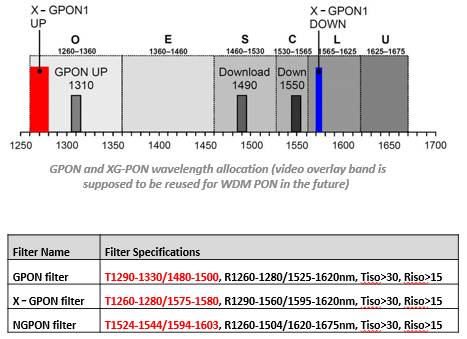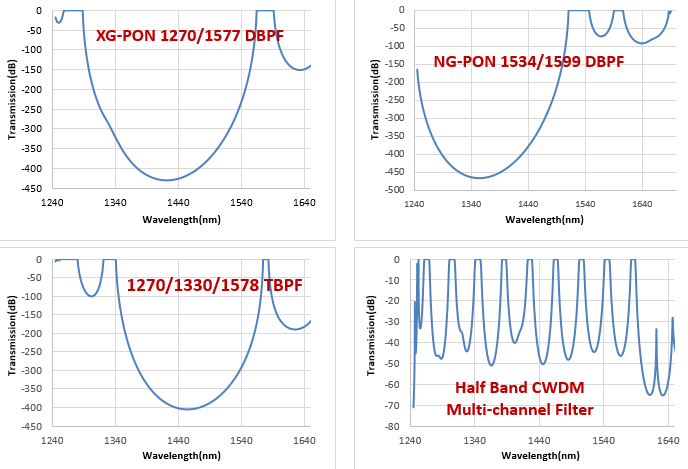In wavelength-division multiplexer (WDM) and passive optical network (PON) modular design, single band pass filters and multiple band pass filters are used to allow narrow wavelength ranges to pass through while rejecting wavelengths outside that range, which is referred to as the upper and lower cut-off frequencies of the filter.
Multiple band pass filters are used to transmit two or more standard coarse wavelength division multiplexing (CWDM) channels, separating them from the other CWDM bands — replacing two or more single band pass filters with a single component.
This article lays out the advantages of using multi-band filters instead of two or more single band filters, detailing the unique expertise of Iridian Spectral Technologies not only as a progenitor of multi-band filter technology but a present leader in the telecommunication applications of multi-band filters. Also discussed is the performance of the WDM module, along with its reliability, cost, and dimension concerns in design and production.
Optimizing Space
Typically, single band pass filters have found application in telecommunications; one filter permits one wavelength range to pass while rejecting other nearby wavelengths. For the wavelengths allowed by a single band filter with a central wavelength of 1500 would cover 1542.5 to 1557.5 nanometers (nm).
The core telecommunication range usually starts around 1250 or 1260 nm to reach between 1650 and 1675 nm, and several single band pass filters may be applied across this range. Specifically, ITU standard CWDM band pass filters permit a 15 nm range and reject 25 nm outside. ITU standards for CWDM require a 20 nm channel spacing each, which allows designers to begin with a central wavelength of 1270 nm, which then progresses to 1290, 1310, 1330, continuing similarly to this.
Iridian and a designer of communications systems in the South Korean market first combined two band pass filters on a single filter chip in 2008. With this, a single filter chip could allow pass bands with one 1310 central wavelength filter and another 1490 nm central wavelength filter, for example. This was instead of using two single band pass filters featuring the same central wavelengths.
It was this new capability that has revolutionized WDM and PON module and system design. It led to the simplification of connections, space conservation inside the module, and the elimination of costs incurred through sourcing and implementing numerous single band filters.
Iridian and its Korean partner had recognized the need in the market for this type of component, and that communications system designers needed technologies to enable and improve long-term evolution (LTE) wireless transmission, which is sometimes referred to as 4G.
The need in the market for multi-band pass filters is determined by several key factors, including:
- The technology demands fifth-generation (5G) wireless transmission from the mid-wave band to the mmWave band
- Consumer devices becoming smaller and smaller in size
- The increasing level of connectivity in a range of technologies, including military, consumer, and medical devices.
At present, the most widely adopted application for multi-band filters is wireless station interconnects for 4G, LTE, and 5G systems. CWDM systems, where reducing the component count and footprint is beneficial (i.e., GPON, XG-PON, and XGS-PON, which use 1310, 1490, and 1550 wavelength channels) can also utilize multi-band filters.
Comparing the Integration of Multi-band Pass Filters and Single Band Pass Filters
Band pass filters do not have stand-alone functionality. It is necessary, as a result of them being a component, that they are packaged.
Inside the component are the filter, two collimating lenses, and fiber lead out. Using two or more single band pass filters within a module, each fiber-connected part has to be individually connected to the others by the designer. However, an alternative method, using a dual-band fiber filter, saves the designer at least one fiber connection. Triple band filters go even further, and combines three distinct filters into a single component, saving designers at least two fiber connections.
Designers benefit from the reduction of the overall footprint of the so-called equipment closets, which are used in the installation of wireless interconnect stations. As the number of stations in 5G networks and the cost of the urban real estate required for the equipment closets steadily increases, this advantage becomes even more critical.
The maximum density possible, meaning the maximum number of filters packaged or bands feasible in one component, is dependent on the specifications of customers. Iridian has achieved nine bands within the range between 1240 nm and 1650 nm. However, dual or triple band filters are more widely used in the telecommunications wavelength range.
Additional bands do not give way to poorer performance. The opposite is true. Multi-band pass filters can produce a flat passband and good reflectance isolation in almost every case. However, it is necessary to keep spacing between channels reasonable, and dead bands cannot be too steep. For example, 20 nm is an achievable band space, but 50 or 60 nm between adjacent passbands is preferable. Otherwise, the filter skews closer to a narrow notch filter.
Overall, using multi-band pass filters simplifies system design, and the performance of the system is improved. Designers can reduce the number of components inside the module, which makes the best use of the module’s space and dimensions. Design is further simplified by reducing the number of fiber connections needed, and removing unnecessary connections also reduces insertion loss.
However, the costs associated with using multiple single bandpass filters over single multi- bandpass filters do not scale linearly with the number of bands. The main deciding factor in cost scaling is the steepness of the dead band, which defines the thickness of the design and establishes how difficult and by extension how expensive the design will be to make.
In short, a design including 5 nm dead bands will present higher costs than a design that includes 10 nm, dead bands. Assuming specification requirements are similar, for instance, the isolation and dead band, the overall cost for a single band filter and a dual-band filter are comparable. On average, a multi-band pass filter will cost approximately 20% more than a single bandpass filter, even though the capability is doubled and the performance and fit are improved with multi-band pass filters. It is important to note, however, that this estimate can vary according to the customer and specifications needed.
Iridian’s Leading Position in the Multi-Band Filter Market
Iridian was the only supplier of multi-band technologies in telecom applications in 2008. Although alternative vendors have since followed Iridian in offering dual-band filters, Iridian still remains the market’s preferred partner. The majority of vendors can handle dual-band filters with typical ranges, namely 1310, 1490, 1270, and 1570, but struggle with more challenging specifications, such as 1534 nm and 1600 nm.
Iridian’s wide-ranging experience has led to the design of dual-band filters as a direct result of the company’s diverse range of capabilities. This allowed Iridian to create components for the most challenging specifications. Additionally, the variety of specifications that customers request is extensive, requiring Iridian to draw on a deep knowledge base.
For example, channel spacing is a key challenge faced in the design of multi-band pass filters. XG-PON (10G-PON) needs two passbands in very close proximity, for example, 1545 and 1600 or 1610, and only Iridian can achieve consistent quality and performance in this range, while ensuring a stable and high-volume supply of these multi-band pass filters (Fig. 2).

Figure 1. Iridian Dual Band Filters in GPON and XG-PON Applications.
Iridian also offers delivery times that are the same for both single-band and dual-band custom components. It is this combination of quality, agility, and capability that has secured Iridian its place as the global market sales leader in this technology.
Summary
Telecommunications is a uniquely challenging technological environment. Vendors and operators are required to cater to the changing demands from private citizens and large corporations, to start-ups, governments, and more.
Multi-band filters provide a means to help designers and manufacturers optimize the balance between price and performance, particularly in WDM and PON modules, while also optimizing space, simplifying design, and improving or offering equivalent performance rates when compared to single band filters.
Iridian does not only supply the telecommunications market. Iridian also offers its expertise to multi-band filter customers in fluorescence microscopy, 3D cinema, laser reflection, and more. This utility and Iridian’s diverse catalog of products has built the company’s expertise and ability to fulfill designers’ optical filter needs beyond traditional applications.

Figure 2. Iridian Multi-band Pass Filter Performance.

This information has been sourced, reviewed and adapted from materials provided by Iridian Spectral Technologies.
For more information on this source, please visit Iridian Spectral Technologies.